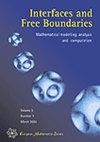具有物理真空的非等熵欧拉方程的适定性
IF 1
4区 数学
Q1 MATHEMATICS
引用次数: 6
摘要
考虑具有运动物理真空边界条件的一维非等熵欧拉方程的局部适定性。物理真空奇点要求声速按到真空边界距离的平方根进行缩放。主要的困难在于双曲守恒律系统在真空边界处变得特征性和简并。我们的证明是基于欧拉方程的退化抛物正则化近似,该近似是由退化人工粘度项的特定选择得到的。然后构造了该退化抛物型问题的解,并建立了关于人工粘度参数的均匀估计。得到了可压缩欧拉方程的解,作为人工黏度消失的极限。与等熵情况\cite{Coutand4, Lei}不同,我们的动量守恒方程有一个额外的项$p_{S}S_x$,这导致能量函数中有一些额外的项,即使对于$\gamma=2$的情况也会造成更多的困难。此外,我们从$2\leq\gamma<3$和$1<\gamma<2 $的一般情况出发来处理这个自由边界问题,而不是只强调\cite{Coutand4, jang1, Lei}中$\gamma=2$的等熵情况。本文章由计算机程序翻译,如有差异,请以英文原文为准。
Well-posedness of non-isentropic Euler equations with physical vacuum
We consider the local well-posedness of the one-dimensional nonisentropic Euler equations with moving physical vacuum boundary condition. The physical vacuum singularity requires the sound speed to be scaled as the square root of the distance to the vacuum boundary. The main difficulty lies in the fact that the system of hyperbolic conservation laws becomes characteristic and degenerate at the vacuum boundary. Our proof is based on an approximation of the Euler equations by a degenerate parabolic regularization obtained from a specific choice of a degenerate artificial viscosity term. Then we construct the solutions to this degenerate parabolic problem and establish the estimates that are uniform with respect to the artificial viscosity parameter. Solutions to the compressible Euler equations are obtained as the limit of the vanishing artificial viscosity.
Different from the isentropic case \cite{Coutand4, Lei}, our momentum equation of conservation laws has an extra term $p_{S}S_x$ that leads to some extra terms in the energy function and causes more difficulties even for the case of $\gamma=2$. Moreover, we deal with this free boundary problem starting from the general cases of $2\leq\gamma<3$ and $1<\gamma<2 $ instead of only emphasizing the isentropic case of $\gamma=2$ in \cite{Coutand4, jang1, Lei}.
求助全文
通过发布文献求助,成功后即可免费获取论文全文。
去求助
来源期刊
CiteScore
1.70
自引率
0.00%
发文量
17
审稿时长
>12 weeks
期刊介绍:
Interfaces and Free Boundaries is dedicated to the mathematical modelling, analysis and computation of interfaces and free boundary problems in all areas where such phenomena are pertinent. The journal aims to be a forum where mathematical analysis, partial differential equations, modelling, scientific computing and the various applications which involve mathematical modelling meet. Submissions should, ideally, emphasize the combination of theory and application.

 求助内容:
求助内容: 应助结果提醒方式:
应助结果提醒方式:


